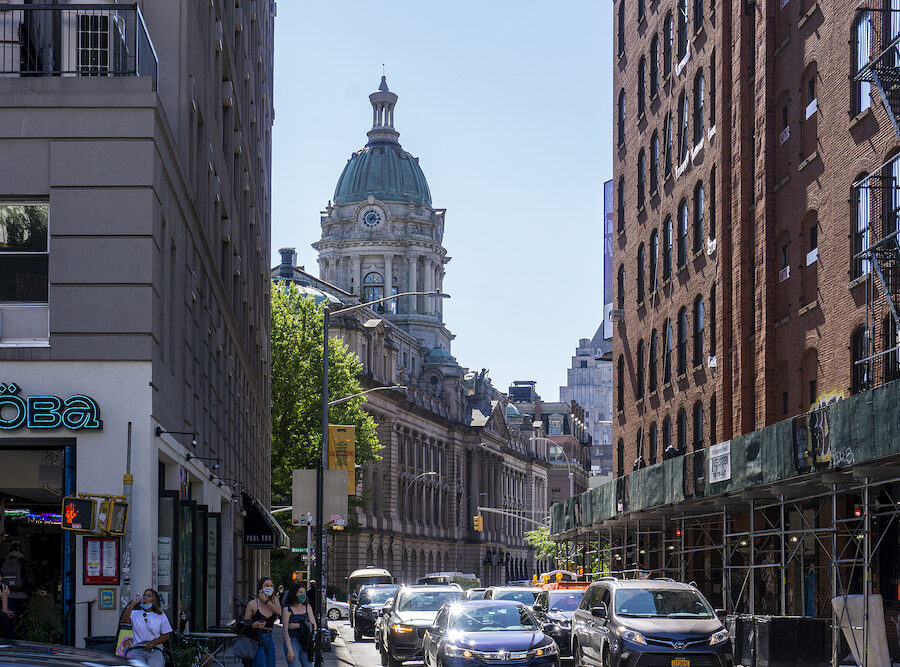New York City Announces ‘Get Sheds Down’ Initiative
By Gregory Fortino
On July 24, New York City Mayor Eric Adams and Department of Buildings (DOB) Commissioner Jimmy Oddo announced new rules for sidewalk construction sheds and scaffolding. The “Get Sheds Down” initiative seeks to improve public safety and enhance quality of life by removing the structures more quickly and replacing them with more attractive or less intrusive alternatives.
Sidewalk Shed Paradigm Shift
The current rules governing sidewalk sheds allow property owners to leave the sheds in place instead of completing the façade repairs that required shed installation. Consequently, roughly 9,000 permitted construction sheds span nearly 400 miles, approximately 3% of the city’s sidewalks, with most of the sheds located in Manhattan commercial districts. The sheds have an average age of 500 days.
The Get Sheds Down plan calls for legislation that would implement monthly financial penalties of up to $6,000 for sidewalk sheds in the public right of way not directly associated with new construction or demolition projects. Recurring penalties would start 90 days after initial shed permitting and continue until the shed is removed.
Owners of properties in select business districts—Midtown Manhattan; Long Island City, Queens; Downtown Brooklyn; and Grand Concourse in the Bronx—could face an additional $10,000 penalty for failing to meet milestones in repairing unsafe façades, in addition to existing DOB penalties for failure to complete façade repairs under the Façade Inspection and Safety Program.
Safety Netting: An Alternative to Sidewalk Sheds
In support of Get Sheds Down, the DOB released Buildings Bulletin 2023-006, which governs the use of safety netting systems as an alternative to sidewalk sheds. The bulletin specifies dual-layer construction, which includes the following:
- Structural netting. A system of nets that complies with the prototype test described in ANSI A10.11.
- Debris netting. A fine-mesh netting of sufficient size and strength to catch debris, such as falling tools and building materials.
Containment netting may be considered only where netting can provide adequate public protection from loose façade materials overhead. Netting cannot be used as a substitute for sidewalk sheds required by BC 3307.6.2.
The bulletin identifies acceptance criteria for containment netting as an alternative to sidewalk sheds and other forms of pedestrian protection, including:
- Design. The design requirements specify accepted materials, netting rated capacity, maximum size of net openings, and anchoring system requirements.
- Netting certification. The netting manufacturer must provide a certificate of compliance prepared in accordance with ANSI/ASSE A10.11 and the manufacturer’s qualification test outlined in ANSI/ASSE A10.37-2016.
- Filing requirements. Registered design professionals must file applications and submit construction documents for installation or removal of containment netting systems in DOB NOW: Build.
- Installation requirements. Containment netting must be installed according to the manufacturer’s instructions and attached with post installed anchors or an anchoring system that conforms to the manufacturer’s requirements.
- Special inspection. Where applicable, containment netting anchoring systems are subject to the requirements of Section BC 1705.37.
- Maintenance. If displaced material falls into the containment netting, the system must be inspected and cleared of loose debris. The netting system and hardware will require periodic inspection.
Transforming Sidewalk Sheds
DOB will issue a public request for proposals to solicit new design ideas that will replace the pipe-and-plywood shed design with less obtrusive, more attractive shed, netting, and carbon fiber wrap designs that are affordable for property owners. By tapping the creative talent of architecture and engineering professionals, the Adams administration seeks to improve the pedestrian experience while providing critical protection from overhead hazards.
Selected designs will be incorporated into New York City Construction Codes, offering building owners and design professionals aesthetically pleasing options in pedestrian protection measures.
Increased Oversight of Existing Sidewalk Sheds
The plan calls for new fees upon renewing sidewalk shed permits, which will decrease in duration from 12 months to 90 days. Building owners will face increased penalties for sidewalk sheds that remain in place after permit expiration—without the benefit of DOB penalty waivers for expired shed permit violations.
In addition, the DOB will expand the Longstanding Shed program, which targets sidewalk sheds older than five years, to include properties with sheds that have been in place for at least three years. Owners of affected properties may qualify for penalty waivers by completing repairs and removing sheds within a certain timeframe.
To discuss the impact of Get Sheds Down on your property, or for other assistance, contact Metropolis Group at 212.233.6344.


